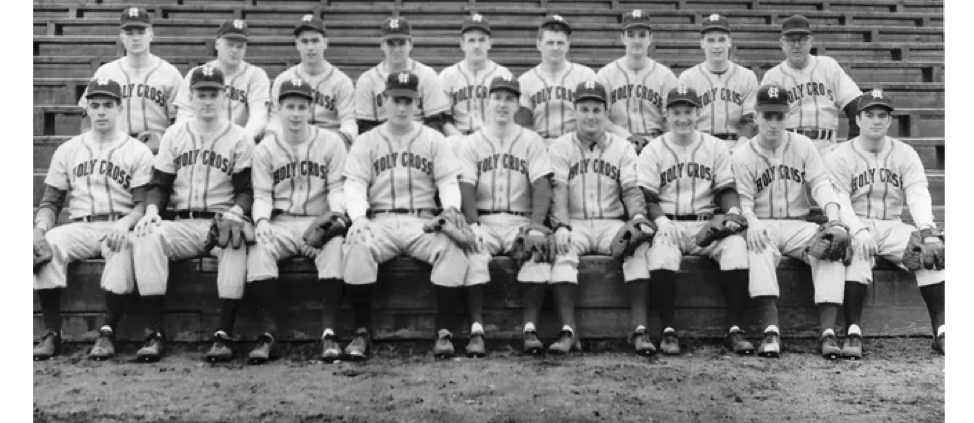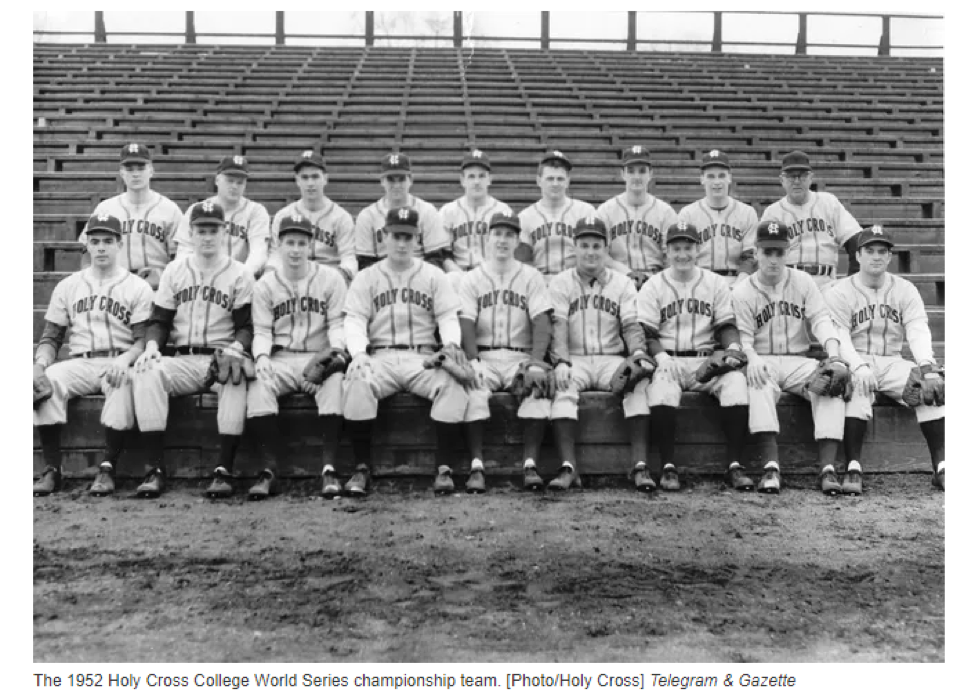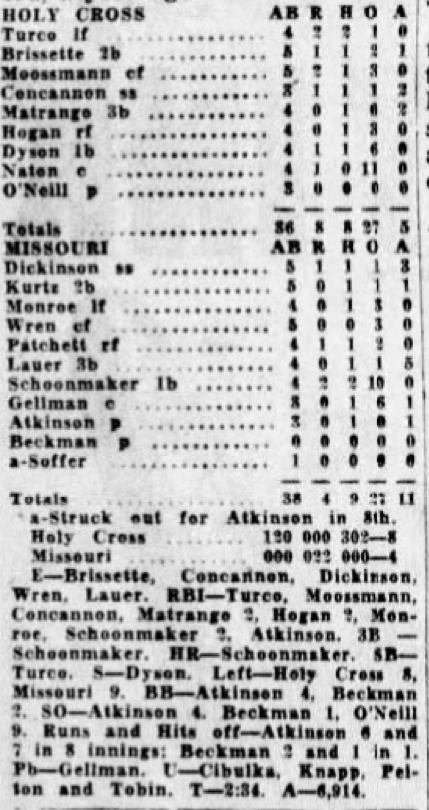June 17, 1952: Holy Cross defeats Missouri to win College World Series
On June 17, 1952, in front of 6,914 fans,1 the University of Missouri, coached by John “Hi” Simmons,2 and the College of the Holy Cross, coached by Jack Barry, a five-time World Series champion as a player with the Philadelphia Athletics and Boston Red Sox,3 faced off in the winner-take-all game of the College World Series4 at Omaha Municipal Stadium.
Holy Cross, located in Worcester, Massachusetts, was trying to become the first team east of the Mississippi to win the championship in the six-year history of the tournament,5 while Missouri was trying to make it two consecutive championships for the Big Seven Conference following the University of Oklahoma’s win in 1951.6
The double-elimination, eight-team tournament had started on June 12 with Duke University, led by star shortstop Dick Groat, being the number-one seed.7 Missouri began strong, winning three straight in three days, earning a day of rest on the fourth day of the tournament. The winning streak included a 1-0 win over Holy Cross on the second day of the tournament, despite Missouri’s getting only one hit.
Holy Cross, having been relegated to the losers bracket, would be playing its seventh game in six days, including a 7-3 defeat of Missouri the previous night that necessitated this final game. Remarkably, during this stretch Holy Cross used only 11 players and did not make a substitution in any of these games.
The starting pitcher for Holy Cross was 6-foot-5-inch right-hander James “Shuffles” O’Neill. O’Neill had already pitched two complete games in the tournament, including one two days earlier in 102-degree afternoon heat. The starting pitcher for Missouri was Dick Atkinson,8 a right-hander who was the winning pitcher in Missouri’s earlier 1-0 victory over Holy Cross.
Holy Cross started quickly when the first batter of the game, left fielder Johnny Turco,9 singled, stole second, and scored on a single by the cleanup hitter, shortstop Jack Concannon.10 Holy Cross increased the lead to 3-0, scoring two runs in the second with only one hit. Right fielder Dick Hogan walked. First baseman Fran Dyson laid down a sacrifice bunt but was safe on an error by third baseman Gil Lauer. Catcher Pete Naton11 attempted another sacrifice, but this time Hogan was forced at third. O’Neill walked, loading the bases. Turco then singled to center, scoring Dyson, and when center fielder Lowe “Junior” Wren bobbled the ball, Naton scored.
The score remained the same until the bottom of the fifth inning, when Missouri first baseman Bob Schoonmaker hit a 380-foot homer over the left-field bleachers. Catcher Herb Gellman followed with a single. After Atkinson fanned, shortstop Dick Dickinson reached on a fielder’s choice. O’Neill seemed out of the inning when second baseman Kent Kurtz12 grounded to short, but Concannon tried to throw the ball to second before he had it secured and all hands were safe. The error proved costly as left fielder Ralph Monroe hit a single, scoring Dickinson with the second run of the inning, making the score 3-2.
Missouri struck again in the bottom of the sixth. Right fielder Jack Patchett opened the inning with a single. Lauer popped out to first baseman Dyson while trying to sacrifice. However, just as he had in the previous inning, Schoonmaker belted an O’Neill pitch, this time 400 feet to center field for a triple, scoring the tying run. Hogan chased down a long foul fly by Atkinson for the second out but was in no position to throw home after the catch, allowing Schoonmaker to come home with the go-ahead run.
Entering the top of the seventh, Atkinson had retired 14 of his last 15 batters, including nine in a row. After getting two more outs, he ran into trouble. He walked Turco and gave up a single to second baseman Paul Brissette. When center fielder Art Moossmann singled to right, Turco scored the tying run and, when the throw went to third to unsuccessfully get Brissette, Moossmann took second. Concannon was walked intentionally to load the bases, but the strategy failed when third baseman Frank Matrango grounded the ball through the infield to the left of second base, scoring two runs and putting Holy Cross up 6-4.
Missouri tried to come back in its half of the inning, getting the first two men on base and brining up Wren, who led the team in batting, home runs, and runs batted in.13 Instead of trying to sacrifice the runners over to get the tying run in scoring position, Wren swung away, and he flied out. When Patchett popped to first and Lauer struck out, the inning was over.
After Missouri’s Atkinson was lifted for a pinch-hitter in the bottom of the eighth, Bert Beckman came in to pitch the top of the ninth. He got the first two outs, but Moossmann reached on an error by shortstop Dickinson. Beckman walked Concannon and Matrango, loading the bases for Hogan. Hogan blasted a single to right, scoring two insurance runs and making the score 8-4. In the bottom of the ninth, Dickinson led off with a single, but Kurtz fanned. Monroe forced Dickinson at second for the second out. When Wren flied out to center, the game and the championship went to Holy Cross.
The win gave Holy Cross a 6-1 record in the tournament with all the games being complete games.14 O’Neill pitched three of those games, all victories, becoming the first man to win three games in the finals. His achievement was reminiscent of the 1910 World Series, when Jack Coombs won three games, leading the Philadelphia Athletics over the Chicago Cubs, particularly since Coombs was the coach who brought the top-seeded Duke team to the 1952 tournament. Coincidentally, Holy Cross coach Barry was the shortstop of the Athletics’ famous “$100,000 infield” and a teammate of Coombs during that World Series.
While O’Neill was named the most valuable player of the tournament, Turco also had an outstanding series, amassing 10 hits in 22 at bats with 11 runs scored in the seven games. As part of the 25th anniversary of the College World Series, a committee selected a College World Series All-Time Team in 1971, and O’Neill and Turco made the second team.15 Of course, special recognition also needs to go to Holy Cross’s other seven position players, who played every inning of every game, and the other two pitchers in the Series, Jack Lonergan (1-1), who lost the 1-0 one-hitter, and Ron Perry16 (2-0), who beat Missouri, 7-3, in the next-to-last game.
While currently Omaha and the College World Series are seemingly inseparable, this was not always the case. What became known as the (Men’s) College World Series started in 1947 in Kalamazoo, Michigan, and was played there again in 1948. In 1949 it was played in Wichita, Kansas, and then moved to Omaha in 1950. One of the significant aspects of the 1952 College World Series is that, largely because of record attendance, it was the first time the series in Omaha was a profitable event.17
Author’s Note
The author would particularly like to thank the staff of Holy Cross’s Archives and Distinctive Collections for their invaluable assistance.
Acknowledgments
This article was fact-checked by Kurt Blumenau and copy-edited by Len Levin.
Sources
In addition to the sources cited in the Notes, the author consulted Baseball-Reference.com and Retrosheet.org for pertinent information. The game account was compiled from the June 18, 1952, editions of the Omaha Morning World-Herald, Worcester Telegram and Gazette, Boston Globe, and Columbia (Missouri) Missourian, as well as the Associated Press account.
(Click image to enlarge)
Notes
1 This brought the total attendance for the series to a record 38,371, which was nearly 11,000 over the previous record set the year before. Robert Phipps, “Holy Cross Captures Series Crown, 8 to 4,” Omaha Morning World-Herald, June 18, 1952: 27. By contrast, the 2023 College World Series set an attendance record of 392,946, for a per-game average across the 16 games of 24,559. Brendan Preisman and Evan Bland, “Starting Woes Catch Up to Gators in Championship Series,” Omaha World-Herald, June 27, 2023: B3.
2 Simmons coached baseball at Missouri from 1937 to 1973, compiling a 481-294-3 record and capturing the NCAA Championship in 1954. Vahe Gregorian, “Former Mizzou Baseball Coach Simmons Dies,” St. Louis Post-Dispatch, January 14, 1995: 4C.
3 John J. “Jack” Barry coached at Holy Cross from 1921 to 1960, compiling a record of 616-150-6 (.802) while never having a losing season. Before that, he played for Holy Cross from 1905 to 1908 and then played with the Philadelphia A’s from 1908 to 1915 and the Boston Red Sox from 1915 to 1917 and 1919. (He missed 1918 due to World War I military service.) He also managed the Red Sox in 1917. Barry was inducted into the College Baseball Hall of Fame in 2007. Holy Cross Athletics Hall of Fame, “John J. Barry,” accessed September 18, 2023.
4 While the tournament is almost always referred to today as the College World Series, in 1952 it was just as likely to be called the National Collegiate Athletic Association (NCAA) Baseball Championship. In fact, the Associated Press story about the game used the phrase “so-called college world series.” Associated Press, “Holy Cross Wins NCAA Baseball Title,” Waterloo (Iowa) Daily Courier, June 18, 1952: 18.
5 As of 2023, Holy Cross was still the only New England team to win the College World Series.
6 In 1952 the Big Seven Conference consisted of Colorado, Iowa State, Kansas, Kansas State, Missouri, Nebraska, and Oklahoma.
7 The eight teams in the tournament were Colorado State College (now known as the University of Northern Colorado), Duke, Holy Cross, Missouri, Oregon State, Penn State, Texas, and Western Michigan. Duke finished 1-2, beating Oregon State, but then losing to Penn State and to Western Michigan in an elimination game.
8 Atkinson was signed by the St. Louis Cardinals right after the series and would have a five-season minor-league career.
9 Turco was named to the Second-Team All-American squad in 1952. “3 Tigers Make All-American,” Columbia (Missouri) Missourian, July 2, 1952: 8. Nonetheless, in the account of the game in the Columbia (Missouri) Missourian, he is referred to as “Don Turko.”
10 After the season Concannon, a Boston native, signed with the Boston Braves and spent three years in their system before finishing up his professional career in the Mexican League in 1955.
11 Naton played with the Pittsburgh Pirates in 1953, his only major-league season.
12 Kurtz, a Third-Team All-American selection in 1952, played three seasons in the New York Yankees organization, including a couple of games with Triple-A Kansas City in 1952 when the team suffered injuries to several key players. “Columbia’s Kent Kurtz Joins Kansas City Blues This Week,” Columbia Missourian, August 11, 1952: 6. “3 Tigers Make All-American,” Columbia Missourian, July 2, 1952: 8.
13 Wren received First-Team Baseball All- American Honors in 1952, along with teammate pitcher Don Boenker and Holy Cross’s O’Neill. A two-sport star, Wren signed with the Chicago White Sox in 1952, but he made his mark in professional sports as a defensive back in the National Football League. “Baseball Award Winners,” NCAA.org, accessed September 18, 2023: 5. Missouri Athletics Hall of Fame, “Junior Wren,” accessed September 18, 2023.
14 Their record for the season was 21-3. Missouri finished with a 20-7 record.
15 “General College World Series Records,” NCAA.org, accessed September 18, 2023: 38.
16 Perry was also a member of the Holy Cross basketball team that won the National Invitational Tournament championship in 1954.
17 Floyd Olds, “Nebraska, Kansas Miss Only One Big Seven Title,” Omaha World-Herald, December 28, 1952: 3C. In fact, the event lost money in 10 of the first 12 years it was played in Omaha (1950-1961). “History,” CWSOmaha.com, accessed October 17, 2023, https://cwsomaha.com/sports/2023/3/13/history.aspx.
Additional Stats
Holy Cross Crusaders 8
Missouri Tigers 4
Omaha Municipal Stadium
Omaha, NE
Corrections? Additions?
If you can help us improve this game story, contact us.




